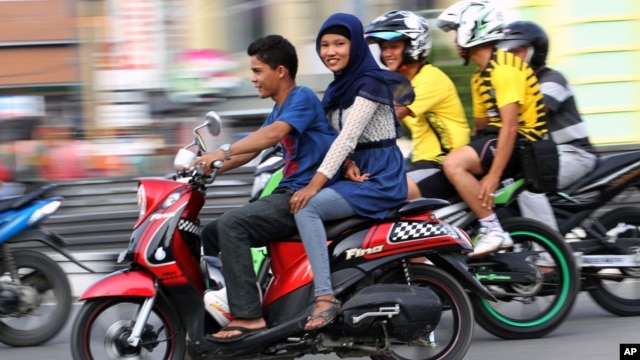
This blog contains lots of articles and world news. Its aim is to be a source of knowledge for people to read and think, and thus make an intuitive decision on how to lead their lives fruitfully in every-day livings.Under the concept of Today-Readers are Tomorrow Leaders.' The world will be better because we begin to change for the best.
วันพฤหัสบดีที่ 31 มกราคม พ.ศ. 2556
เหรียญหลวงพ่อแดงรุ่นแรก
เหรียญดังเมืองเพชร หลวงพ่อแดงวัดเขาบันไดอิฐ พ.ศ. ๒๕๐๓ คนเมืองเพชรยากได้มาก เพราะความศักดิ์สิทธิ์ของท่านและอภินิหาร การเช่าหาควรศึกษาเรื่องตำหนิที่ด้านหน้าของเหรียญจะมีเส้นโค้งเหนือศรีษะของท่านไปยังตัวอออ่างบางๆเป็นธรรมชาติบางๆ และลอยลักษณะวงกลมตรงขอบเหรียญด้านล่างสุด และลอยเสี้ยนด้านหลังที่บริเวรขอบ ของแท้จากblockเดียวกัน ลอยเสี้ยนจะไปในแนวทางเดียวกัน
ประวัติ
ชาตุภูมิ : ต.บางจาก อ.เมือง จ.เพชรบุรี
เกิด :
วันพุธ ขึ้น 2 ค่ำ เดือน 11 พ.ศ. 2422
บิดา
มารดา ชื่อ : นายแป้น นางนุ่ม นามสกุล อ้นแสง
มรณภาพ
: 16 มกราคม พ.ศ. 2517
วัยเยาว์
ท่านก็ช่วยพ่อแม่ทำไร่
ทำนา ไม่มีโอกาสร่ำเรียนหนังสืออย่างเด็กสมัยนี้จนกระทั่งอายุ 20 ปี พ่อแม่ก็หวังจะให้บวชเรียน
จึงพาไปฝากกับท่านอาจารย์เปลี่ยน วัดเขาบันไดอิฐ
เพื่อจะได้เล่าเรียนและบวชเป็นพระภิกษุต่อไป
บรรพชิต
พระภิกษุแดงเมื่อได้บวชก็ประพฤติเคร่งครัดต่อพระวินัยและปฏิบัติต่อพระอาจารย์เปลี่ยนเป็นอย่างดี
อาจารย์เปลี่ยนจึงรักใคร่มากกว่าศิษย์คนอื่นๆและยังได้สอนวิชาการวิปัสสนา
และวิธีนั่งปลงกัมมัฏฐานให้ รวมถึงถ่ายทอดวิชากฤตยาคมให้อย่างไม่ปิดบังหวงแหน
เหตุนี้จึงทำให้พระภิกษุแดงเพลิดเพลินในการศึกษาวิชาความรู้จนลืมสึกยิ่งนานวันก็ยิ่งสำนึก
ในรสพระธรรม ก็เลยไม่คิดสึกเลย จึงกลายเป็นพระปฏิบัติดีปฏิบัติชอบที่มีอาวุโสสูงสุด
จนกระทั่งพระอาจารย์เปลี่ยนมรณภาพลง
พระภิกษุแดงรับหน้าที่เป็นสมภารวัดเขาบันไดอิฐแทน กลายเป็น "หลวงพ่อแดง"
ตั้งแต่ พ.ศ. 2461 เป็นต้นมา
และแม้ท่านจะได้เป็นสมภารซึ่งต้องมีภารกิจมาก แต่ท่านก็ยังปฏิบัติธรรม นั่งสมาธิในถ้ำเพื่อแสวงหาวิมุตติภาวนาทุกวัน
ญาณสมาธิจึงแก่กล้า จิตนิ่ง บริสุทธิ์ จนว่ากันว่าท่านมีหูทิพย์ ตาทิพย์
อภินิหาร
ในระหว่าง พ.ศ. 2477 ถึง พ.ศ. 2480 เวลานั้นเกิดโรคระบาดสัตว์ วัยควายเป็น โรครินเดรอ์เปรส
ซึ่งเป็นโรคปากเท้าเปื่อยที่ติดต่อร้ายแรง พากันล้มตายเป็นเบือ
สัตว์แพทย์ก็ไม่มีต้องขอให้ทางการมาช่วยฉีดยา
ราษฎรจึงพากันไปหาหลวงพ่อให้ช่วยปัดเป่าป้องกันโรคระบาดสัตว์ให้ด้วย
หลวงพ่อแดงจึงปลุกเสกลงเลขยันต์ในผืนผ้ารูปสี่เหลี่ยมเล็กๆแจกให้ชาวบ้านที่เลี้ยงวัวควายนำไปผูกปลายไม้ปักไว้ที่คอกสัตว์ของตน
ปรากฏผลว่า คอกสัตว์ที่ปักผ้าประเจียดยันต์หลวงพ่อแดงไม่ตายเลย
ทุกบ้านในตำบลใกล้เคียงวัดเขาบันไดอิฐ
เมื่อรู้กิตติศัพท์จึงพากันมาขอยันต์หลวงพ่อแดงทุกวันมิได้ขาด
กระทั่งเกิดสงครามโลกครั้งที่ 2 คือมหาสงครามเอเชียบูรพา
มีทหารญี่ปุ่นมาขึ้นที่ประจวบคีรีขันธ์ ก็เกิดการต่อสู้กับทหารอากาศของไทยที่นั่น
ชาวเพชรบุรีก็ตระหนกตกใจ แล้วชักชวนกันหาหลวงพ่อแดง ท่านก็ลงผ้าประเจียดยันต์แจก
ให้คุ้มครองป้องกันตัว
เมืองเพชรบุรี เมื่อ พ.ศ. 2487 เกิดภัยสงครามชนิดร้ายแรง
มีระเบิดลงทุกวันทำลายสถานีรถไฟ สะพานข้ามแม่น้ำ บ้านเรือน โรงเรียนต้องสั่งปิด
ข้าราชการไม่ได้ไปทำงาน ทุกหน่วยราชการปิดหมด และปรากฏเรื่องเป็นที่ฮือฮาว่า
บ้านคนที่มีผ้ายันต์หรือห้อยเหรียญหลวงพ่อแดง กลับไม่ได้รับอันตรายใดๆเลย
หลวงพ่อแดงจึงดังใหญ่จนสิ้นสงครามโลกครั้งที่ 2 กิตติคุณของหลวงพ่อในทางกฤตยาคมจึงปรากฏความศักดิ์สิทธิ์แพร่หลายยิ่งขึ้น
ความศักดิ์สิทธิ์ของหลวงพ่อแดงปรากฏอีกครั้ง
เมื่อเกิดคอมมิวนิสต์ญวนเหนือบุกญวนใต้ ประเทศไทยต้องส่งกองพันเสือดำ
ออกไปช่วยพันธมิตรรบในญวนใต้ก็ปรากฏว่าทหารไทยทีไปปฏิบัติหน้าที่รบในเวียดนาม
คนที่มีเหรียญหลวงพ่อแดงห้อยคออยู่ ไม่ถูกอาวุธเป็นอันตรายแก่ชีวิตสักคน
ทั้งๆที่เข้าประจัญบานอย่างหนักเป็นที่สงสัยของเพื่อนทหารต่างชาติว่าทหารไทยมีของดีอะไร
ได้รับคำตอบจากทหารไทยว่ามี "เหรียญหลวงพ่อแดง"
ท่านเป็นพระใจดีมีเมตตาสูง
และอารมณ์ดีเสมอ ไม่ชอบดุด่า ว่าใครโดยเฉพาะคำหยาบคายถึงพ่อแม่ท่านห้ามขาด
ท่านว่าทุกคนเขาก็มีพ่อมีแม่ การด่าถึงบุพากรีทำให้ความดีงามเสื่อมถอย
ถึงห้อยพระพระท่านก็ไม่คุ้มครอง
มรณภาพ
หลวงพ่อแดงมรณภาพด้วยโรคชรา
เมื่ออายุ 96 ปี พรรษาที่ 74 ก่อนมรณภาพท่านเคยพูดกับพระปลัดบุญส่ง
ธัมมปาโล รองเจ้าอาวาสวัดขณะนั้นว่า "เมื่อฉันหมดลมหายใจแล้วอย่าเผา
ให้เก็บร่างฉันไว้ที่หอสวดมนต์ และให้เอาเหรียญที่ปลุกเสกรุ่น 1 ใส่ปากไว้พร้อมเงินพดด้วง 1 ก้อน
ส่วนนี้ฉันเอาไปได้และให้เอาขมิ้นมาทาตัวฉันให้เหลืองเหมือนทองคำ
พระบุญส่งจึงรับปาก และได้ทำตามที่หลวงพ่อประสงค์ทุกอย่าง
เรื่องเล่า
หลังจากที่หลวงพ่อแดงมรณภาพแล้วก็ได้เกิดเหตุอัศจรรย์ที่เป็นเครื่องพิสูจน์ว่า
อภินิหารของหลวงพ่อแดงมีจริง กับผู้หลักผู้ใหญ่ของเมืองเพชรบุรีท่านหนึ่ง
ซึ่งจู่ๆท่านก็มีนิมิตฝันเห็นบ่อน้ำโบราณที่ซ่อนตัวอยู่ใต้ต้นก้ามปูใหญ่
พอขุกก็พบบ่อน้ำนั้นจริงๆ
บ่อน้ำแห่งนี้หลวงพ่อแดงเคยพูดไว้สมัยที่ท่านยังมีชีวิตอยู่ว่าเป็น
"บ่อน้ำวิเศษ" และขณะที่ขุดยังพบ "หัวพญานาคสีขาว"
แบบปูนปั้นอยู่ที่ก้นบ่อด้วย 1
หัว
เมื่อชาวบ้านรู้ข่าวก็พากันแห่มาเพื่อจะตักน้ำเอาไปใช้กันแต่ปรากฏว่าพบงูใหญ่ตัวหนึ่งนอนขดอยู่ใต้สังกะสีที่เอาไว้ปิดปากบ่อ
ชาวบ้านที่เห็นบอกว่า ลักษณะงูที่เห็นนั้นมีหงอนที่หัวด้วย ตั้งแต่นั้นมาก็ไม่มีชาวบ้านกล้าเข้าไปตักน้ำที่บ่อนี้อีกเลย
ที่น่าแปลกอีกก็คือ
นายตำรวจท่าหนึ่งซึ่งเคยมาช่วยงานในวัดก็ฝันเห็นหลวงพ่อแดง ท่านมาต่อว่า
"ทำอะไรทำไมไม่บอก"
นายตำรวจก็ไปเล่าให้พระปลัดบุญส่งเจ้าอาวาสรูปปัจจุบันฟัง
ท่านก็ไม่เชื่อแล้วยังสั่งให้ย้ายศาลเก่า 2 ศาล บริเวณเชิงเขาบันไดอิฐเพื่อปรับปรุงบริเวณ
โดยไม่ยอมทำพิธีเซ่นไหว้เจ้าที่เจ้าทาง เพราะท่านเป็นคนไม่เชื่อไสยศาสตร์
ปรากฏว่าพอตกเย็นก็เกิดอาการผิดปกติ อยู่ๆคอก็เริ่มบิดและตัวแข็งไปทั้งตัว
ขยับไม่ได้ ชาวบ้านมาเยี่ยมเห็นว่าอาการหนักมากจึงช่วยกันพาส่งโรงพยาบาลเปาโล
แต่พอถึงโรงพยาบาล อาการที่เป็นกลับหายราวปลิดทิ้ง
และเมื่อเอ็กซเรย์พร้อมตรวจอย่างละเอียดก็ไม่พบว่าเป็นอะไรเลย
และระหว่างที่นอนพักรักษาตัวอยู่ท่านก็พูดออกมาคนเดียวโดยไม่รู้ตัวว่า
"ของดีมีอยู่ ผ่านไปผ่านมาไม่ใช้ต้นก้ามปูตรงนั้นเป็นบ่อน้ำ ให้ขุดลงไปแล้วจะเจอ
มีของดีทำไมไม่รักษา"
ในภายหลังที่ออกจากโรงพยาบาลแล้วพระครูโสภณพัฒนกิจ (หลวงพ่อบุญส่ง
ธัมมปาโล)ก็ได้ฝันอีกครั้ง ในความฝันท่านเห็นคนนุ่งผ้าถกเขมรมาหา
มาบอกว่าเขาเป็นคนมัดหลวงพ่อเอง
พูดแล้วเขาก็เอามือรีดที่ตัวหลวงพ่อเหมือนรีดเอาไขมันออก ทั้งขาและแขน จนหลวงพ่อพระปลัดบุญส่งสะดุ้งตื่นและพอตื่นขึ้นมาก็ยังเห็นผู้ชายคนนั้นอยู่ในห้องพอถามชื่อ
เขาก็ถอยออกไปแล้วตอบกลับมาว่า "เขาเป็นเปรต"
จากนั้นก็หายวับกลายเป็นแสงไฟ พร้อมเสียง "วี๊ด" ดังมาก
ซึ่งพระในวัดก็ไดยินกันทั่ว เรื่องนี้ได้ทำให้ "พระครูโสภณพัฒนกิจ (บุญส่ง ธัมมปาโล)"
เจ้าอาวาสวัดเขาบันไดอิฐรูปปัจจุบันยอมรับว่าอภินิหารของหลวงพ่อแดงนั้นมีจริงเพราะเจอแล้วด้วยตัวท่านเอง
สหธรรมิก
“พระครูญาณสาคร” หลวงพ่อแฉ่ง สำเภาเงิน (สีลปญฺโญ)
วัดปากอ่าวบางตะบูน ตำบลบางตะบูน อำเภอบ้านแหลม จังหวัดเพชรบุรี “พระครูอโศกธรรมสาร” หลวงพ่อโศก วัดปากคลอง ตำบลบางครก
อำเภอบ้านแหลม จังหวัดเพชรบุรี “หลวงพ่อทองศุข
อินทโชโต” วัดโตนดหลวง ตำบลบางเก่า อำเภอชะอำ
จังหวัดเพชรบุรี “หลวงพ่อแฉ่งเมือง ปญญมาโค” วัดคงคาราม อำเภอเมือง จังหวัดเพชรบุรี
ภาพประกอบเหรียญรุ่นแรก เนื้อทองแดง สวย หายาก ใครที่สนใจให้ติดต่อทาง e-mail หลักแสนกลาง/เหรียญเงินหายากสุดๆ ราคาแพงมากเพราะจำนวนการผลิตน้อย
ม.โชคชัย ทรงเสี่ยงไชย
--------------------------------------------------------------------------------------------
วันจันทร์ที่ 28 มกราคม พ.ศ. 2556
Is this the beginning of Burma’s Truth and Reconciliation process?
Sunday, 27 January 2013 11:59
Myat Thu Pan
(COMMENTARY) — Burma has enjoyed more than 20 months of near euphoria and cautious hope as it emerges from 50 years of military dictatorship.

Archbishop Desmond Tutu Photo: The Elders
The way the current government handled this crisis reminded me of a similar Truth and Reconciliation process that was led by Bishop Desmond Tutu in South Africa. That movement began the transition to end apartheid and took them on their journey toward democracy in the 1990s.
In Africa, the process began after the first true democratic elections. Here, in Burma it also seems to have happened after the first democratic election of 2010—though that was regarded as a sham election. Whatever it may have been, the media and the public has been more or less cautious in its criticism and judgment of the severe police crackdown on November 29 and the plight of the monks who participated.
Aung San Suu Kyi must be credited for setting the tone and rational judgments in her public addresses on the issue; and, for her willingness to lead the government-installed commission. Her handling of the crisis shows that she has grown into her role as a lawmaker in a mature and capable way. The demonstrators' trust in her has played a large role in calming them and preventing an emotional escalation.
The government must also be credited for forming a fact-finding state commission led by Aung San Suu Kyi.
Since the crackdown, independent media has been cautious not to incite more violence. At the same time, they have encouraged the government to come clean about the incident and explain to the public about the extractive investments made by the past military regime.
This incredible process means that the people are voicing their opinions openly on the streets, in tea shops and market places without a shadow of fear over their heads. But the media and the population wants the real truth behind the violence and an admission of the excessive force used upon the peaceful demonstrators.
There is a general consensus that the situation should not deteriorate further and revert to the old military style handling. So far, the police who handled the demonstrators have come out and confessed to the local Sangha leader and asked for spiritual advice. This is a welcome first step towards the process of Truth and Justice, which can be likened to the Truth and Justice process in South Africa.
In a recent admission by the Minister for Religious Affairs, he acknowledged the mistake of the heavy handed handling of the crisis to the Supreme Sangha Council—this may not be the final contrition that the population is looking for, but at least it is a consolation that the government realizes its wrongful way of dealing with peaceful demonstrations.
What the President will say to the nation on this topic will show whether he can sustain the enormous credibility and trust as the main architect of the reforms that he has already carried out for the nation.
All he has to do as the titular head of a democratically aspiring nation is to take responsibility for the debacle.
Now the stark difference in this crisis is that Rangoon is chock full of monks and people demonstrating. I did not see a single soldier out in the streets nor tanks surrounding the city while I was there. This is in contrast to crises of the past and may be the most crucial test of the present military-backed government in its intention to democratize the nation.
Burma is trying to heal from a half century of pain, lack of human rights, countless deaths and injuries throughout the military rule and terrible poverty suffered by millions. If this is the beginning of the healing process, it should be maintained at all costs by the government and the media, the pundits, the MPs, the villagers of Latpadaung, environmental and monk activists, and the general public.
One hopes that a spontaneous and true Burmese way to Truth and Justice, as in South Africa, is unfolding with a fair resolution to the question of the copper mines; although this will be extremely difficult.
Recently, Thitagu Sayadaw requested that the mass demonstrations stop until the fact-finding commission announces a result. Perhaps the Venerable Sayadaw will take on Truth and Reconciliation program in Burma like Bishop Desmond Tutu did in South Africa.
Lastly, there is a wonderful example for the present situation in the admission of Minister Soe Thein a few days before the crisis when he expressed contrition of the past wrongs. It is a pity that the news of his admission appeared in only one journal—the mine crisis seems to have overshadowed his brave action. One can say he is a brave warrior of a different genre: a warrior of the heart, but not of might.
He may have started an incredible process of self-examination by reforming himself like de Klerk of South Africa did in his address after South Africa gained full democracy.
Wine making takes root in long-isolated Myanmar
 View PhotoA woman works in a vineyard at the Red Mountain estate near Inle Lake in Myanmar's …
View PhotoA woman works in a vineyard at the Red Mountain estate near Inle Lake in Myanmar's …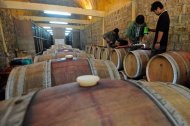 View PhotoWorkers fill wine barrels at the Red Mountain estate near Inle Lake in Myanmar's …
View PhotoWorkers fill wine barrels at the Red Mountain estate near Inle Lake in Myanmar's …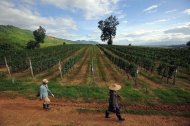 View PhotoWorkers walks past a vineyard at the Red Mountain estate in Shan State, Myanmar on …
View PhotoWorkers walks past a vineyard at the Red Mountain estate in Shan State, Myanmar on …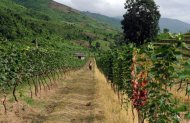 View PhotoA worker walks through a vineyard at the Red Mountain estate near Inle Lake in Myanmar's …
View PhotoA worker walks through a vineyard at the Red Mountain estate near Inle Lake in Myanmar's …
Myanmar may be best known for its decades of junta
rule, but behind the bamboo curtain maverick entrepreneurs have toiled
for years to put the nation on the map for the quality of its wine.
Vines cascade down terraces overlooking the vast mirror of Inle Lake
in northeastern Myanmar, an unlikely setting for a budding wine industry
tempting the tastebuds of tourists now flocking to the country as it
opens up."Everybody is surprised to see a vineyard here in the middle of Myanmar with all this modern equipment," said Francois Raynal, winemaker at the Red Mountain estate in Shan State.
The vineyard, which produces roughly 120,000 bottles a year that fetch about 10,000 kyat ($11) apiece, has itself become a draw for foreigners intrigued that vines could grow in the tropical country.
Many visitors are Europeans with a "strong wine culture" who want to try the local tipple, said Raynal, a Frenchman who has worked at the winery for a decade.
Myanmar's wine pioneer was German Bert Morsbach, who spearheaded the country's original vineyard, Aythaya, after a colourful career in Southeast Asia.
He began working in Myanmar from 1989 exporting organic basmati rice, but turned to vines after the business was confiscated by a government minister.
In 1998 he planted 4,000 vines imported from France in eastern Karenni state, but a simmering insurgency between the army and ethnic rebels flared in the area and the government forbade him from tending his vineyard.
"That was my first experience with wine. Then 'I said I like it here, so much that I will give it another chance with another region up there in Shan State,'" Morsbach told AFP.
The challenges of wine growing in Myanmar are not just related to its complex political history.
Although it is known for its fertile soil, the country's tropical climate and relatively short days during the June-July peak budding period mean only a few grape types are able to thrive.
"Fungus is our biggest enemy. Greenhouse conditions here mean it often grows much better than grapes," said Hans Leiendecker, the German director of wine operations at Aythaya, which expected to sell 100,000 bottles in 2012 and double that number this year.
Shan State's clouded hills give the vineyard an elevation of around 1,100 metres (3,600 feet) above sea level, meaning the vines enjoy cooler temperatures than in other tropical areas.
"It's cold and that produces the nice aromas," Leiendecker said.
Consumers, however, seem to have more of a thirst for red wines and Aythaya has found that Shiraz grows well. It is also testing German Dornfelder, Tempranillo and Chianti.
Myanmar's winemakers have by necessity been "very experimental" and could develop well in the coming years, following in the footsteps of China, Thailand and India, said Denis Gastin, an Australia-based writer specialising in Asian wine.
He said the success of Myanmar's trailblazing vineyards has encouraged a number of smaller operations to bud -- a situation likely to please hoteliers clamouring for local wines.
"We are happy to present a product from our own land. Also it is a quality product. It is fantastic wine," said Yin Myo Su, who runs the upmarket Inle Princess hotel.
"I hope we won't be limited to two vineyards -- we could have 20," she said.
Myanmar's international image has seen dramatic improvement as it emerges from decades of military rule, with President Thein Sein taking office in 2011 and overseeing dramatic political reforms including the election of democracy champion Aung San Suu Kyi to parliament.
Foreigners have enthusiastically flooded in, filling hotels to capacity.
Red Mountain, owned by a Myanmar businessman, sells its wine predominantly at the country's tourist hot spots like Yangon, Mandalay and the ancient temple complex of Bagan.
But rival Aythaya's vineyard and restaurant is close to the bustling Shan state capital Taunggyi where the majority of custom is from locals, including wealthy businessmen.
The long-term nature of the business -- the number of bottles produced depends on crops planted several years before -- means that even if tourism soars, it will take years before it flows through into production.
But is the wine good?
Gastin tested the Red Mountain range at a tropical wine symposium last year and was "pretty impressed".
"I was quite shocked about the Sauvignon Blanc and Pinot Noir, I thought they were really very very good," he said.
At Red Mountain, Swiss vineyard owner Serge Heymoz -- who was visiting the estate while on holiday -- also gave the wine the seal of approval.
"It is very interesting indeed, but let's be clear -- interesting in a good way," he said.
วันอาทิตย์ที่ 27 มกราคม พ.ศ. 2556
Myanmar is Becoming Burma
Monday, 10 October 2011 13:30
B.G. Verghese
(Commentary) – Myanmar seems to be returning to Burma. The good news has trickled in after talks between Aung San Suu Kyi and the new civilian president, Thein Sein, established a framework for national reconciliation and graduated democratic reform.

B.G. Verghese has been with the Centre for Policy Research in India since 1986.
Perhaps even more significantly, work on the US$ 3.6 billion, 6,000-megawatt Myitsone dam on the upper Irrawaddy River, under construction with Chinese assistance, has been suspended as being “against the will of the (Kachin) people).” The decision was announced in parliament and suggests that the Burmese leadership is not going to kow-tow to its giant neighbour which has established a major presence in the country during the past 22 years of isolation and Western sanctions, which started after 2003. This does not bring Chinese collaboration to an end by any means as numerous other large hydroelectric, hydrocarbon, port and other infrastructure projects are moving forward.
It does, however, suggest that the new regime is mindful of ethnic minority and ecological sensitivities. After years of cease-fires based on a policy of live and let live, the regime sought to integrate ethnic nationality armies into the Myanmar armed forces on the eve of the last elections by declaring them national border guards under the command of the Tatmadaw. Most refused, and four insurgencies have resumed in consequence. Aung San Suu Kyi has appealed for restraint, a further cease-fire and peace talks, to which the regime has not been entirely unresponsive.
This too marks a potentially significant development as its resolution will determine whether Burma is to be a truly federal state, with ethnic nationalities enjoying considerable autonomy, or remain a largely centralised polity at war with itself. Suu Kyi’s father General Aung San, the Father of the Nation and first prime minister, had negotiated the Panglong agreement with the minorities in 1948. The one issue on which it broke was on the interpretation of whether the option to review federal ties after a decade implied a choice of independence or only a re-jigging of the federal arrangement. It was on the identical issue in regard to the 9-Point Hydari agreement that the Naga leader, Phizo, broke with the Indian State.
The Thein Sein government is seeking foreign investment and collaboration in every field. It is a country with enormous land and natural resources (minerals, bio-diversity, hydro power and hydrocarbons) but currently lacking in human capital - administrative, entrepreneurial, institutional, scientific expertise – after decades years of military rule. It is because of this that it has farmed out major development projects, including plantations, to China, its Asean neighbours, Japan, India and others. Only a small fraction of its 40,000-meawatt hydro potential has been harnessed though almost 14,000 megawatts worth of projects have been signed up (especially with China on the Irrawaddy). With little domestic demand as yet, most of this power will be exported to China, Thailand and the Asean grid, and to adjacent Nagaland if the 1,200-megawatt Tamanthi project, part of the Chindwin cascade, comes to fruition with Indian assistance.
India’s major project so far has been the Kalewa/Kalemayo-Tamu (Moreh) highway (along which projected Indo-Burma-Asean trade has been stymied for lack of trade facilitation measures on the Indian side). An even larger project under implementation is the multi-modal Southern Mizoram-Kaladan River-Sitwe Port corridor whicb will provide India’s Northeast an ocean outlet. The Kaladan Corridor may, alas, go the way of the Kalewa-Tamu Road unless concurrent steps are taken here and now by both governments and all concerned actors – transporters, entrepreneurs, bankers, freight forwarders, hoteliers, and others – get their act together.
Around 1998, Burma had offered extensive wastelands to India to grow rice, pulses and palm oil on renewable 30-year leases. Thailand and Malaysia signed up. India was unresponsive. Whether such leases will again be on offer and will be acceptable to the ethnic minorities is uncertain. However, it is something that could be explored on the basis of cooperative partnerships with local ethnic groups, the Burma government and the Indian state or private entrepreneurs as a means of coupling ethic settlements in Burma with income and employment generation and the development of much-needed infrastructure.
Hydrocarbon exploration and exploitation, onshore and offshore, is another area that holds out considerable promise.
Burma has had a long and close association with India and has applied for Saarc membership, which Delhi supports. The country is also a member of Asean of which it hopes to become rotational chair in 2014. It is in transition and holds a geo-strategic position of high importance as a bridge between Saarc, Asean and China.
Rather than be a passive spectator or late actor, India should move energetically to engage the new Thein Sein administration to assist and encourage its transition to full democracy, ethnic reconciliation and economic and social reconstruction at all levels, governmental and non-official.
Aung San Suu Kyi studied in Delhi and is greatly revered here and has high regard for this country. India’s relations with the military regime have also been maintained at an even keel and the military leadership too trusts India as a non-intrusive neighbour and long-term friend.
Why shouldn’t the government and credible civil society institutions invite delegations of Burmese parliamentarians, trade representatives, ethnic nationality groups and security analysts to visit India and talk to their counterparts and potential collaborators here? Scholarships and seats in training institutions should be readily on offer as this is perhaps Burma’s greatest need. Charter flights should be organised both ways to promote tourism and understanding. And high level Indian political and trade and investment delegations should visit Burma as early as possible.
The Indo-Afghan strategic partnership agreement signed last week on the occasion of President Karzai’s visit to Delhi need not be a model but could point a direction. Afghanistan is in flux. America’s AfPak policy has failed and it is now locked in a huge muddle and spat with a defiant but bewildered Pakistan that knows it needs to redefine itself. This again presents India with an opening and an opportunity to further its engagement with Islamabad as much as with Kabul and jointly with both. Pakistan’s concerns about winning strategic depth in Afghanistan against India are unreal in concept and substance. India is no threat to Pakistan which is its own worst enemy.
– BG Verghese has been with the Centre for Policy Research in India since 1986. He started his career in journalism with the Times of India and was later editor of the Hindustan Times (1969-75) and Indian Express (1982-86). For more information, see www.bgverghese.com
ชี้แนะนำการเล่นพระสมเด็จ พระเครื่องของท่านสมเด็จโต
การเล่นพระสมเด็จนั้น ไม่ใช่เรื่องยากอะไรเลย แต่ที่เล่นเพื่อ promote พระสมเด็จแท้ของตนเองนั้นคือปัญหา และมักก่อความวุ่นวายในสังคมพระเครื่องไม่จบสิ้น ผู้เขียนขอแนะนำว่า พระสมเด็จแท้นั้นสามมารถพบหาและเช่าได้ไม่ใช่เรื่องยากเกินไปเลย เพียงแต่ว่าต้องหมั่นแสวงหา อย่ากล้วของเก๊ หลักการที่ผู้เขียนใช้ในการแสวงหาพระสมเด็จนั้น ก็คือการเอาใจเขาใส่ใจเรา แล้วดำเนินการตามหลักการนั้น ซึ่งจะอธิบายให้ทราบดังนี้
การเล่นพระสมเด็จนั้นโดยสากลนิยมยึดหลัก"พิมพ์ถูกเนื้อใช่และธรรมชาติถึงยุค" แต่นี่ไม่เพียงพอ ท่านต้องยึดหลักการเอาใจของท่านมาใส่ใจของเราประกอบไปด้วยทุกๆครั้งในการแสวงหาพระสมเด็จ
๑.ท่านสมเด็จโตเป็นคนรู้คุณค่าของวัตถุสิ่งของเครื่องใช้บูชาและแม้แต่อาหารการกินที่เกี่ยวพันธ์ถวายแก่พระสงฆ์และพระศาสนา ทุกอนูมีคุณค่าในความศักดิ์สิทธิ์
๒.ท่านเป็นคนเรียบง่าย/จริงใจ/จริงจังไม่ถือเจ้ายศเจ้าพิธี
๓.ท่านเป็นคนรู้จักดัดแปลง/แก้ไขและนำมาใช้สิ่งของทุกอย่างที่อยู่ใกล้ตัวให้เกิดประโยชน์
๔.ท่านเป็นคนรู้จักใช้รู้จักคิดรู้จักแนะนำและสร้างให้เกิดกำลังใจเรียนรู้
๕.ท่านเข้าใจธรรมชาติได้ดีเยี่ยม
ห้าหัวข้อนี้คือหลักการใหญ่ที่ท่านเป็นตัวของท่านเอง และดังนั้นการสร้างพระสมเด็จหลักการห้าข้อนี้จึงอยู่ในรูปพระสมเด็จที่ท่านสร้าง ฟังดูยากแปลกๆใช่ไหม แต่นี่แหละคือศาสตร์ลึกลับที่ท่านจะได้พระสมเด็จที่แท้จริง ท่านไปลองพิจารณาฝึกฝนเอง
พระสมเด็จเมื่อท่านไปพบว่าพิมพ์ถูกเนื้อใช่แล้วท่านต้องถามตัวเองว่าพระองค์นั้นๆจะเข้าคุณสมบัติข้างต้นของสมเด็จโตไหม ถ้าท่านเข้าใจ นั้นแหละคือพระสมเด็จของท่านโตอย่าดูตำหนิพิมพ์เพราะนั้นเป็นเรื่องการpromote พระเครื่องเพื่อปั่นราคา พระแท้ของตนเองที่เซียนพระเครื่องร่วมกับนิตยสารพระเครื่องร่วมมือกันทำมาตลอดเพื่อขายพระให้ได้ราคาเป็นล้านๆ และก่อปัญหาให้กับวงการคนเล่นพระเสมอมา
นักเล่นพระเครื่องถ้ารู้จักหลักการข้างต้นนี้ท่านจะแสวงหาพระสมเด็จได้ง่ายดายและมักไม่ผิดหวัง
ดูภาพประกอบพระสมเด็จ พิมพ์เกศบัวตูม
ม.โชคชัย ทรงเสี่ยงไชย
การเล่นพระสมเด็จนั้นโดยสากลนิยมยึดหลัก"พิมพ์ถูกเนื้อใช่และธรรมชาติถึงยุค" แต่นี่ไม่เพียงพอ ท่านต้องยึดหลักการเอาใจของท่านมาใส่ใจของเราประกอบไปด้วยทุกๆครั้งในการแสวงหาพระสมเด็จ
๑.ท่านสมเด็จโตเป็นคนรู้คุณค่าของวัตถุสิ่งของเครื่องใช้บูชาและแม้แต่อาหารการกินที่เกี่ยวพันธ์ถวายแก่พระสงฆ์และพระศาสนา ทุกอนูมีคุณค่าในความศักดิ์สิทธิ์
๒.ท่านเป็นคนเรียบง่าย/จริงใจ/จริงจังไม่ถือเจ้ายศเจ้าพิธี
๓.ท่านเป็นคนรู้จักดัดแปลง/แก้ไขและนำมาใช้สิ่งของทุกอย่างที่อยู่ใกล้ตัวให้เกิดประโยชน์
๔.ท่านเป็นคนรู้จักใช้รู้จักคิดรู้จักแนะนำและสร้างให้เกิดกำลังใจเรียนรู้
๕.ท่านเข้าใจธรรมชาติได้ดีเยี่ยม
ห้าหัวข้อนี้คือหลักการใหญ่ที่ท่านเป็นตัวของท่านเอง และดังนั้นการสร้างพระสมเด็จหลักการห้าข้อนี้จึงอยู่ในรูปพระสมเด็จที่ท่านสร้าง ฟังดูยากแปลกๆใช่ไหม แต่นี่แหละคือศาสตร์ลึกลับที่ท่านจะได้พระสมเด็จที่แท้จริง ท่านไปลองพิจารณาฝึกฝนเอง
พระสมเด็จเมื่อท่านไปพบว่าพิมพ์ถูกเนื้อใช่แล้วท่านต้องถามตัวเองว่าพระองค์นั้นๆจะเข้าคุณสมบัติข้างต้นของสมเด็จโตไหม ถ้าท่านเข้าใจ นั้นแหละคือพระสมเด็จของท่านโตอย่าดูตำหนิพิมพ์เพราะนั้นเป็นเรื่องการpromote พระเครื่องเพื่อปั่นราคา พระแท้ของตนเองที่เซียนพระเครื่องร่วมกับนิตยสารพระเครื่องร่วมมือกันทำมาตลอดเพื่อขายพระให้ได้ราคาเป็นล้านๆ และก่อปัญหาให้กับวงการคนเล่นพระเสมอมา
นักเล่นพระเครื่องถ้ารู้จักหลักการข้างต้นนี้ท่านจะแสวงหาพระสมเด็จได้ง่ายดายและมักไม่ผิดหวัง
ดูภาพประกอบพระสมเด็จ พิมพ์เกศบัวตูม
ม.โชคชัย ทรงเสี่ยงไชย
President Hillary Clinton? If she wants it
By David Rothkopf, Special to CNN
January 26, 2013 -- Updated 2107 GMT (0507 HKT)
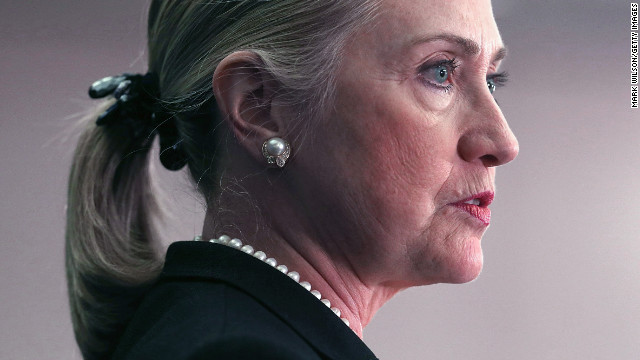 Secretary of State Hillary
Clinton, pictured in October, has become one of the most powerful people
in Washington. Here's a look at her life and career through the years:
Secretary of State Hillary
Clinton, pictured in October, has become one of the most powerful people
in Washington. Here's a look at her life and career through the years:
HIDE CAPTION
Hillary Clinton through the years
<<
<
1
2
3
4
5
6
7
8
9
10
11
12
13
14
15
16
17
18
19
20
21
22
23
24
25
26
27
28
29
30
31
32
33
34
35
36
37
38
39
40
41
42
43
44
45
46
47
48
49
50
51
52
>
>>
STORY HIGHLIGHTS
- David Rothkopf says if Hillary Clinton runs in 2016, she'll likely be the next president
- He says she's most popular politician in country, has political traction and funders in place
- He says she's excelled as secretary of state, overcome adversity, shown political wits
- Rothkopf: Whatever your party, hard to deny she lifts political discourse like few others
Editor's note: David Rothkopf is CEO and editor-at-large of
the FP Group, publishers of Foreign Policy magazine, and a visiting
scholar at the Carnegie Endowment for International Peace. He is the
author of, among other books, "Running The World: The Inside Story of
the National Security Council and the Architects of American Power,"
served as deputy under secretary of commerce for international trade
policy in the Clinton administration and for two years as managing
director of Kissinger Associates.
(CNN) -- There are few certainties in American
politics. But you can write it down: If Hillary Clinton wants to be the
next nominee of the Democratic Party to be president, the job is hers.
Joe Biden, Andrew Cuomo,
Mark Warner, Martin O'Malley and the others in the long list of
commander-in-chief wannabes will go about their day jobs for the next
couple years, but at the back of their minds will be only one question:
Will she or won't she?
Because, as the most
popular politician in America -- who also happens to be married to
America's most popular ex-president and who has in place a nationwide
network of donors, campaign staffers and committed supporters -- Clinton
has the power to keep potential rivals from raising money or gaining
political traction simply by saying, "I haven't decided what my plans
are." She's in control.
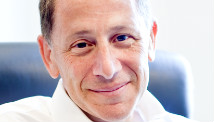
David Rothkopf
That she should be in
such a position at this moment is a remarkable achievement and an
extraordinary testament to her grit, gifts and track record: She has
been the most successful U.S. secretary of state in two decades. That
outcome was hardly a foregone conclusion when Barack Obama made the bold
decision to pick his former primary rival to assume the oldest and most
senior post in the Cabinet.
She had, after all, lost a
bruising campaign to him, there was tension between her team and his
and no reason to assume the two ex-rivals would work together. She had
never run a large organization before. Beyond that, the United States
was facing massive crises at home and bewildering complexity abroad.
Many of the issues she would be facing would be new to her.
Clinton was so famous
already that she could easily be seen to be upstaging the president,
something that would have undone her within the administration and made
her look bad.
Her tour de force
performance this week before Senate and House committees looking into
the Benghazi tragedy illustrated how far she has come. In a charged
political environment, she commanded the stage and deftly repulsed
effort after effort by Republican partisans to shift the focus away from
what the lessons of the attacks were and should be, turning aside their
theories of conspiracy and devious motives for the missteps surrounding
the event. She defended the president and revealed her character by
accepting responsibility.
Become a fan of CNNOpinion
Stay up to date on the latest opinion, analysis and conversations through social media. Join us at Facebook/CNNOpinion and follow us @CNNOpinion on Twitter. We welcome your ideas and comments.
She had already set the
stage with her swift embrace of a blue-ribbon investigation into the
incident and her acceptance of its recommendations for avoiding such
problems in the future. She was helped by the bipartisan recognition of
her extraordinary tenure at State; her work ethic, miles traveled and
commitment were praised throughout both hearings.
Most importantly,
Clinton clearly knew her brief better than any of those questioning her.
When Sen. Ron Johnson of Wisconsin attempted to score political points
with a cynical line of questioning, she showed her strength and stature
as a leader with a direct, unwavering response urging him to focus on
the bigger issues at hand.
When Sen. Rand Paul
announced that had he been president he would have fired her, her
response evinced an understanding of the issues and processes at play;
it was evident that only one of the two of them had any chance of
occupying the Oval Office in the future. When describing the return of
the caskets of the American victims in the Benghazi attack, she showed
her humanity. Frequently, she showed the comfort with the setting that
comes from her experience not just at State but as a senator.
Clinton's virtuosity in
such situations is no accident, nor is it a surprise to any who have
watched her grow, first as a senator and then at State. Having been
tested as few have been by the extraordinary stresses she faced as first
lady, she famously earned her stripes in the upper chamber of our
Congress by being "a workhorse not a show horse." Her close aides at
State speak with some awe about her hours spent immersed in her briefing
papers, her questioning of her staff and top experts to get up to
speed, and her political skill in translating her conclusions into
actions.
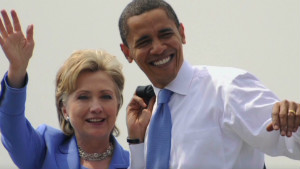 Clinton and Obama: Rivals to partners
Clinton and Obama: Rivals to partners
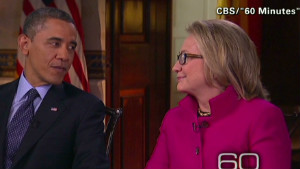 Obama, Clinton explain joint interview
Obama, Clinton explain joint interview
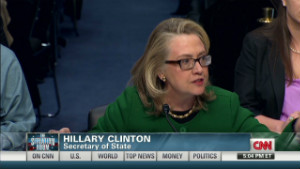 Clinton, senators clash over Benghazi
Clinton, senators clash over Benghazi
She has worked on
forging not only a good working relationship with the president but also
in building key alliances in the Cabinet, notably with former Secretary
of Defense Robert Gates and top officials in the military and the
intelligence community. When the White House limited her brief and
asserted control over key issues, from the appointment of ambassadors to
a host of issues in the Middle East, she found alternative paths to
make a difference.
The "pivot" to Asia was
one concrete example of her success -- not as merely a policy concept
but as an initiative made real by active, intensive diplomacy throughout
the region. She helped restore U.S. relations worldwide that had been
damaged by the bull-in-a-china-shop policies of the George W. Bush
administration. She actively worked
to reshape the American international agenda for the 21st century,
focusing on emerging powers, new technologies and populations -- like
the role of women worldwide -- long neglected by the U.S. foreign policy
establishment.
She led the way for the United States to be more active in Libya, to manage unprecedented international sanctions against Iran, to stand up to
the Chinese in the South China Sea. Indeed, perhaps most importantly,
at a time when the U.S. faced distractions and new constraints at home
and a national desire to avoid military entanglements worldwide, she
recognized that our greatest tools going forward would be active
diplomacy and repaired alliances, and she restored them to centrality in
U.S. foreign policy.
It is a stand-out
record, one that makes her the equal of the likes of James Baker, George
Schultz or Henry Kissinger among our leading modern secretaries of
state. What is more, she achieved her success by promoting a more
humanist international agenda than her peers at the first ranks of
American foreign policy leaders. At the same time, she maintained a
centrist course more comfortable with the appropriate use of force than
many of her more liberal colleagues in the Obama administration.
Maintaining such a balance requires exceptional skill. To do so for four
years under the conditions she faced is among the reasons she is so
widely admired.
Hillary Clinton is
likely to be the next Democratic presidential nominee because she is the
best-known active Democratic politician, because she has repeatedly
triumphed over adversity, because she has made herself well-liked at a
time that politicians are typically viewed with contempt.
But she is likely to be
the next president, the first woman to be president of the United
States, because of the quality of her character and her work on behalf
of the American people. With some luck she will use the next two years
to restore her energy and prepare for what lies ahead. Because
regardless of what political party in which you may find yourself, it is
hard to deny that she elevates our political discourse in ways that
few, if any, others do on the contemporary stage.
วันศุกร์ที่ 11 มกราคม พ.ศ. 2556
Aceh Town Bans Women From Straddling Motorbikes
An Acehnese woman straddles on a motorbike on a road in Lhokseumawe, Aceh province, Indonesia, January 7, 2013.
TEXT SIZE
Kate Lamb
January 11, 2013
JAKARTA — In Indonesia’s province of
Aceh, where Islamic law governs, adultery, gambling, tight jeans and
Mohawk haircuts are outlawed by religious police. Now, women passengers
have been banned from straddling motorbikes. The new bylaw has sparked
strong criticism with activists saying that discriminatory regulations,
seemingly justified by Islam, are undermining Indonesia’s pluralist
reputation.
In the Aceh town of Lhokseumawe, the moral crusade continues.
Town Mayor Suaidi Yahya says local morals are slipping - and it’s ‘impolite’ for women to straddle motorbikes.
Religious leaders have expressed support for the new regulation, but women’s groups say it is ridiculous and unfair. They say local laws enacted in the name of religion and morality have disproportionately affected women.
Andi Yetriyani from the national body on women’s rights says the bylaw is a big step backwards for Aceh, and for Indonesia.
“Basically this is a discriminatory regulation against women," Yetriyani stated. "It is also undermining the whole movement for advancing human rights in Indonesia.”
So why aren’t Achenese women taking to the streets?
Yetriyani says it’s not so easy.
“These bylaws you know are framed under the sharia, so many of the Indonesian people do not dare to challenge it because you [they] will be condemned as against Islam,” Yetriyani said.
Women’s groups in Aceh say the local ordinance is a waste of money - as more moral police will be recruited to enforce it.
They argue that regional funds would be better spent on improving health and education.
Aceh was granted regional autonomy when a peace deal between the central government and Achenese separatists was brokered in Helsinki in 2005.
Since the agreement, and the subsequent introduction of sharia law, reports of human rights violations have steadily increased.
Andreas Harsono from Human Rights Watch says that a number of local laws in Aceh violate freedom of expression, association and religion.
“These violations not only violate international human rights law but also violate the Helsinki agreement between Indonesia and the Free Aceh Movement in which both sides agreed they are to protect and promote human rights,” he said.
The Indonesian Home Affairs Ministry says it will review and potentially repeal the motorbike bylaw.
The ministry has blocked more than 2,000 local laws across the country, but it has never revoked a sharia bylaw in Aceh.
Critics say the central government is reluctant to condemn hardline Islamic views.
But in Aceh, freedom of expression and association continue to be restricted on the grounds of Islamic morality. And minority religious groups are also under pressure. Almost 30 churches were shut down in the province last year.
Harsono says that Islam in Indonesia is starting to bear some uncomfortable parallels with Pakistan - and that moderate voices are being drowned out.
“The thing is, more radical fundamentalist Muslim speakers are more outspoken. The battle is still going on. We still do not know what will be coming out of it. Although, we are nervous to see statistically the number of discriminatory bylaws are increasing," Harsono noted. "So I’m afraid it is going to be a long dark era. When will it end? When will it be enough is enough?”
In a country where the majority of the population holds moderate Islamic views, Aceh is the only Indonesian province governed by sharia law.
Aceh residents have been informed the new bylaw is expected to be implemented in the coming months.
In the Aceh town of Lhokseumawe, the moral crusade continues.
Town Mayor Suaidi Yahya says local morals are slipping - and it’s ‘impolite’ for women to straddle motorbikes.
Religious leaders have expressed support for the new regulation, but women’s groups say it is ridiculous and unfair. They say local laws enacted in the name of religion and morality have disproportionately affected women.
Andi Yetriyani from the national body on women’s rights says the bylaw is a big step backwards for Aceh, and for Indonesia.
“Basically this is a discriminatory regulation against women," Yetriyani stated. "It is also undermining the whole movement for advancing human rights in Indonesia.”
So why aren’t Achenese women taking to the streets?
Yetriyani says it’s not so easy.
“These bylaws you know are framed under the sharia, so many of the Indonesian people do not dare to challenge it because you [they] will be condemned as against Islam,” Yetriyani said.
Women’s groups in Aceh say the local ordinance is a waste of money - as more moral police will be recruited to enforce it.
They argue that regional funds would be better spent on improving health and education.
Aceh was granted regional autonomy when a peace deal between the central government and Achenese separatists was brokered in Helsinki in 2005.
Since the agreement, and the subsequent introduction of sharia law, reports of human rights violations have steadily increased.
Andreas Harsono from Human Rights Watch says that a number of local laws in Aceh violate freedom of expression, association and religion.
“These violations not only violate international human rights law but also violate the Helsinki agreement between Indonesia and the Free Aceh Movement in which both sides agreed they are to protect and promote human rights,” he said.
The Indonesian Home Affairs Ministry says it will review and potentially repeal the motorbike bylaw.
The ministry has blocked more than 2,000 local laws across the country, but it has never revoked a sharia bylaw in Aceh.
Critics say the central government is reluctant to condemn hardline Islamic views.
But in Aceh, freedom of expression and association continue to be restricted on the grounds of Islamic morality. And minority religious groups are also under pressure. Almost 30 churches were shut down in the province last year.
Harsono says that Islam in Indonesia is starting to bear some uncomfortable parallels with Pakistan - and that moderate voices are being drowned out.
“The thing is, more radical fundamentalist Muslim speakers are more outspoken. The battle is still going on. We still do not know what will be coming out of it. Although, we are nervous to see statistically the number of discriminatory bylaws are increasing," Harsono noted. "So I’m afraid it is going to be a long dark era. When will it end? When will it be enough is enough?”
In a country where the majority of the population holds moderate Islamic views, Aceh is the only Indonesian province governed by sharia law.
Aceh residents have been informed the new bylaw is expected to be implemented in the coming months.
สมัครสมาชิก:
บทความ (Atom)



